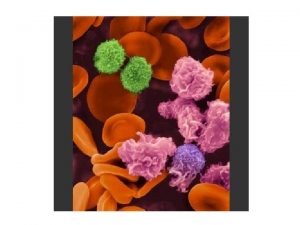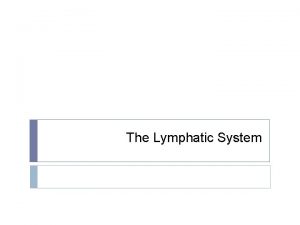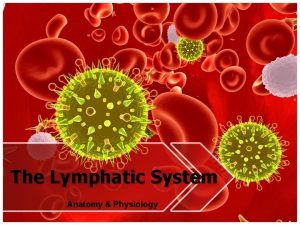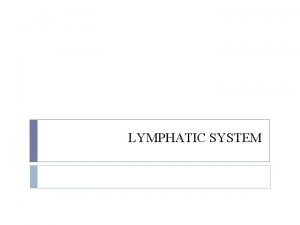HUMAN ANATOMY LECTURE SEVENTEEN LYMPHATIC SYSTEM LYMPHATIC SYSTEM










- Slides: 10

HUMAN ANATOMY LECTURE SEVENTEEN LYMPHATIC SYSTEM

LYMPHATIC SYSTEM FUNCTIONS • Fluid balance - extra interstitial fluid (from capillaries) enters lymphatic vessels - now called lymph • Fat absorption - absorbs fat from digestive tract (villi) into lacteals • Defense - microorganisms and other foreign substances are filtered from the lymph by lymph nodes Lymphatic system consists of: • lymph - fluid component • lacteals - remove fat from digestive tract • lymphatic vessels - carry lymph • lymphoid tissues and organs - tonsils, lymph nodes, spleen, thymus gland

LYMPHATIC VESSELS • Carry lymph in one direction - from tissues to circulatory system • Fluid moves from extra cellular space into lymphatic capillaries - tiny, closed ended vessels with very thin walls of simple squamous epithelium - overlapping squamous cells act as valves to prevent backflow - found in all body tissues except CNS, bone marrow and tissues without blood vessels (epidermis, cartilage) • Lymphatic capillaries join to form lymphatic vessels - similar to small veins with one-way valves - superficial lymphatics and deep lymphatics collect lymph from capillaries • Lymph drains into the cisterna chyli (saclike chamber) of the thoracic duct and into the left subclavian vein - from abdomen, pelvis, lower limbs • Lymph from head, neck, chest, upper limbs drains into the right lymphatic duct and empties into the right subclavian vein


LYMPH ORGANS • Made up of lymphatic tissue consisting of many lymphocytes held by fine reticular fibers • Lymphocytes are formed in the red bone marrow and act as part of the immune system by increasing in number when exposed to microorganisms

TONSILS • Large lymphatic nodules on walls of pharynx • 3 kinds: phayngeal - near internal opening of nasal cavity palatine - on each side of posterior opening of oral cavity “tonsils” lingual - posterior surface of tongue • Form protective ring around opening of oral and nasal cavities

LYMPH NODES • Small, round nodules distributed along lymphatic vessels - lymph passes through before entering blood • Three aggregations of nodes: - inguinal nodes in the groin - axillary nodes in the armpits - cervical nodes in the neck • Surrounded by a dense connective tissue capsule and divided by trabeculae into compartments of lymphatic tissue (lymphocytes) and lymph sinuses (spaces containing macrophages within fibrous network) • As lymph travels through the node (i) immune system may be activated to produce more lymphocytes (ii) removal of microorganisms by macrophages

SPLEEN • • Contains the largest amount of lymphatic tissue in the body Located in the left, superior corner of abdominal cavity Surrounded by a capsule of collagen and elastic fibers Contain two kinds of lymphatic tissue: White pulp - surrounds arteries within the spleen, resemble lymph nodes Red pulp - associated with the veins, contains large number of macrophages

• Cells detect and respond to foreign substances in the blood and destroy worn out RBC’s as blood passes through the red pulp • Stores iron as RBC’s broken down • Initiates immune response in response to antigens in the blood • Acts as a resevoir for blood - can let blood out in an emergency (ie/ hemorrgage)

THYMUS • • Located in superior mediastium just posterior to the sternum Capsule divides it into two thymic lobes separated by the septa Each lobule consists of a dense cortex and a central medulla Lymphocytes (T cells) divide in the cortex and move to the medulla – where they mature and eventually move into the blood
 Dance moms seventeen magazine
Dance moms seventeen magazine Seventeen symbols
Seventeen symbols Parfoy
Parfoy Seventeen table
Seventeen table Lymphatic system outline
Lymphatic system outline 01:640:244 lecture notes - lecture 15: plat, idah, farad
01:640:244 lecture notes - lecture 15: plat, idah, farad Lymphatic system vs endocrine system
Lymphatic system vs endocrine system Lymphatic system and urinary system
Lymphatic system and urinary system Management fifteenth edition
Management fifteenth edition Human resources management chapter 1
Human resources management chapter 1 Human resource management lecture chapter 1
Human resource management lecture chapter 1


















